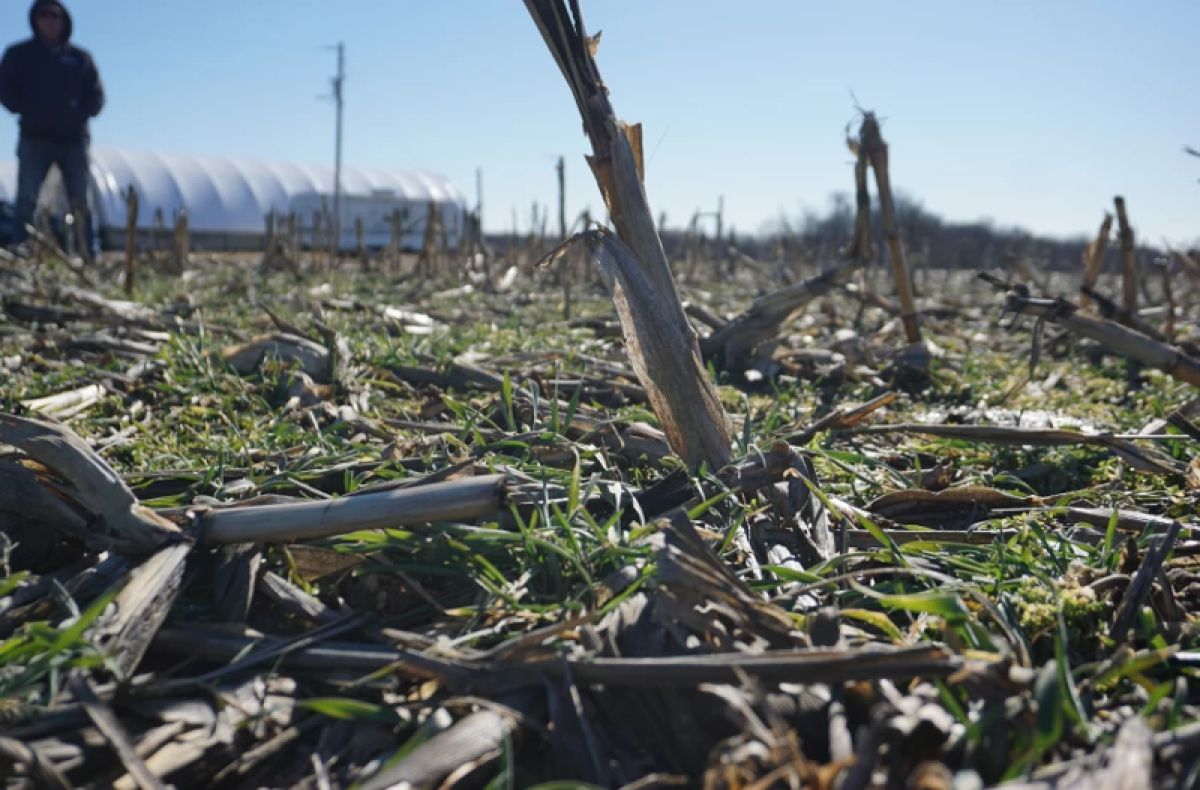
Farmer Tim Gottman stands in the distance overlooking a harvested corn field on his farm in northeast Missouri. The green vegetation in between the old stalks is rye, a cover crop that can help keep the soil healthy. (Jonathan Ahl / Harvest Public Media)
Tim Gottman’s 2,400 acre farm in northeast Missouri looks harvested, but among the remnants of corn stalks are blobs of green plants that are thriving despite the cold and windy conditions of late winter in the Midwest.
His land includes wide swaths that gently slope away from the road, and the water from a recent rain is pooling up in some places.
“All this water would be running that way and if this green, the wheat and rye weren't here, it would just allow the water to run faster and take the soil with it,” Gottman said. “And when the soil is leaving your fertilizers going with it.”
Gottman is a big fan of cover crops, and he says they are working to improve the bottom line on his corn and soybean farm. And he’s not alone.
The University of Illinois completed a study late last year using a combination of USDA reports and satellite images to produce the most accurate survey of cover crop usage in the Midwest. The study found In the past 10 years, the number of acres with cover crops tripled — from 1.8% to 7.2%.
It’s a big jump, but still a small number of acres.
“It is certainly not at a level that would be necessary for some of the challenges, like the water quality challenges like soil erosion,” said Jonathan Coppess, director of Agriculture Policy at the University of Illinois. “It's going to take a lot more acres to get there.”
Cover crops also received a temporary boost, thanks to COVID-19 relief money. The Biden administration spent $60 million on subsidies for more than 12 million acres of cover crops during the 2020-2021 growing seasons.

While that money was temporary, Coppess said it may set the stage for more sustained efforts to incentivize cover crops.
Coppess and other cover crop advocates hope that a big leap could come if more incentives are put in the farm bill, which is up for renewal this year. With all the benefits of cover crops — from reducing fertilizer use and costs; increasing yields; limiting erosion and keeping carbon in the ground — Coppess said there could be more bipartisan support for incentives.
“It can maybe help jump start that by showing, you know, funds going in for this practice will get response on the ground, and we can measure it,” he said.
The current farm bill expires in September, and incentives for cover crops will be a tiny sliver of what looks to be a more than a half a trillion dollar package.
Cover crop usage is also getting endorsements from large agriculture groups, including the National Corn Growers Association and American Soybean Association. Kurt Boeckman is director of Environmental Programs for Missouri Corn Growers Association and also works on national initiatives. He said while there has been a lot of progress, there needs to be more.
“I am a little bit surprised that we're only at 7-8%, and I think that's part of the effort now, is to figure out, ‘Okay, how do we get that 15% in the next five years,’” he said.
Boeckman’s focus has been on education and getting resources to farmers who want to plant cover crops. He said the farm bill could be part of that expansion, but he also thinks it’s important for farmers that it’s a choice — not a mandate.
“We don't want farmers to be forced into planting cover crops on their acres. We want them to make those decisions,” Boeckman said. “They know their land better than anyone.”
Gottman agrees. Even though he uses cover crops on 65% of his fields, he said farmers have to do it for the right reasons, specifically that it works for them and improves the quality of their land.
“Chasing grants and programs doesn’t work. You have to be committed,” he said. “For me, it's more to make the land at least as good as it was when we got it, if not better because we're just stewards of it.”
This story was produced in partnership with Harvest Public Media, a collaboration of public media newsrooms in the Midwest. It reports on food systems, agriculture and rural issues. Follow Harvest on Twitter: @HarvestPM.













